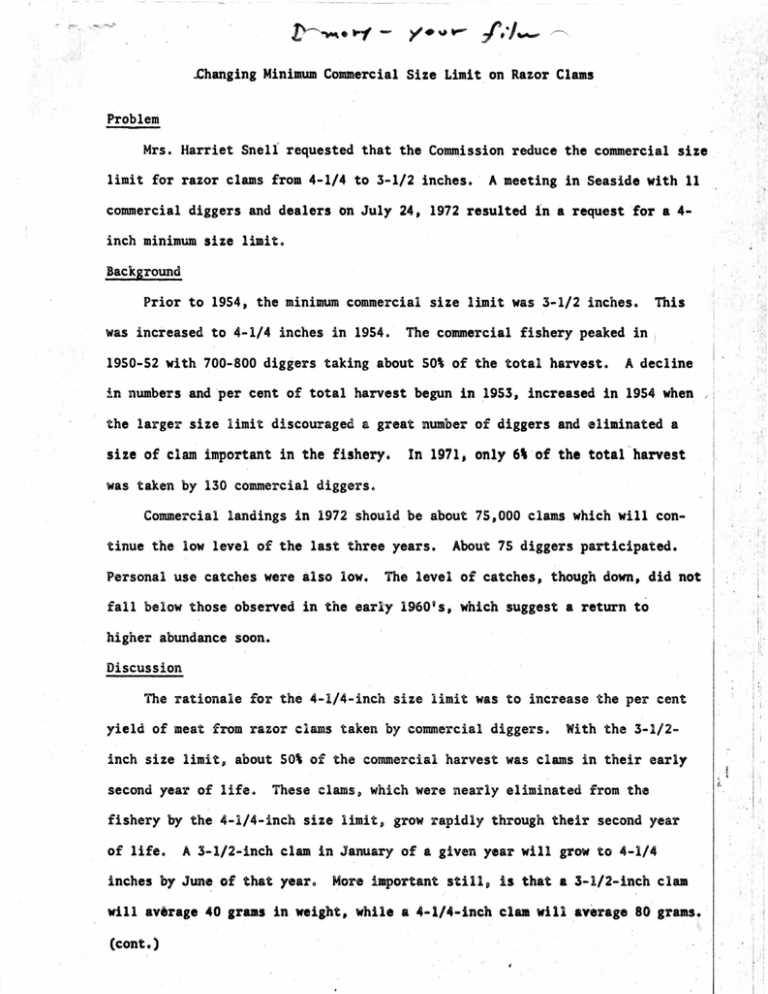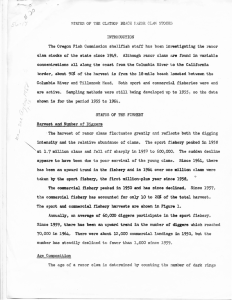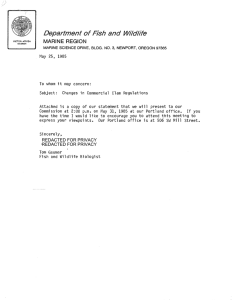Minimum Commercial Size Limit on ... Problem Mrs. Harriet Snell requested that the
advertisement

·.. . . . . ._... ~· t-~ ~hanging Minimum Commercial Size Limit on Razor Clams Problem Mrs. Harriet Snell requested that the Co~ission reduce the commercial size limit for razor clams from 4-1/4 to 3-1/2 inches. · A meeting in Seaside with 11 commercial diggers and dealers on July 24, 1972 resulted in a request for a 4· inch minimum size limito Background Prior to 19S4, the minimum commercial size limit was 3-1/2 inches. was increased to 4-1/4 inches in 19S4o The commercial fishery peaked in 19SO-S2 with 700-800 diggers taking about SO\ of the total harvest. This 1 A decline in numbers and ·per cent of total harvest begun in _1953, increased in 19S4 when the larger size limit discouraged m great number of diggers and eliminated a size of elam important in the fishery. In 1971, only 6\ ·of the total 'harvest was taken by 130 commercial diggers. Commercial landings in 1972 should be about 75,000 clams which will continue the low level of the last three years. Personal use catches were also low. About 75 diggers participated. The level of catches, though down, did not fall below those observed in the early 1960vs, which suggest a return to higher abundance soon. Discussion The rationale for the 4-1/4-inch size limit was to increase the per cent yield of meat from razor clams taken by commercial diggerse With the 3-1/2- inch size limit, about SO\ of the commercial harvest was clams in their early r .; second year of lifeo These clams, which were nearly eliminated from the fishery by the 4-l/4-inch size limit, grow rapidly through their second year of lifee A 3-1/2-inch clam in January of a given year will grow to 4-1/4 inches by Jun~ of that year. More important stillp is that a 3-1/2-inch clam will average 40 grams in weight, while a 4-l/4-inch clam will average 80 grams • . (cont.) -2\ , .. I I So, in five months, a 3-1/2-inch clam will increase in length by 10\• but in weight by 100\. Catch records show that the peak of the commercial harvest ' ! I occurs in May and June after the clams have I . ! had a chance to spawn, mat~red, ; ' I I . I j and achieved most of their growth. I I I; I! I I I I I < ; ·. I The increased size limit created problems concerning management of the I resource and economics of the fishery. I 1 ' i , Several hundred commercial diggers 1 I \ ! 1 were required to sort the 3-1/2 to 4-1/4-inch clams from their digging efforts. 1 I [. · Few diggers can distinguish between the "shows" of 3-1/2-inch clams and 4-1/4' inch clams. I Most of the undersized clams were discarded onto the beach or ) ,, into the water, with little effort on the part of the diggers to replace the · clam back into the sand. Ten years of observations by a staff biologist . convinced him that most .of these discarded clams die. In 1966, an estimated 90,000 .clams were discarded by commercial diggers. The second problem~ an economic one, was the loss of the size of clam most desired by the restaurant trade and which brought the highest price to the digger. Neither of these problems had a significant effect on the clam stocks, but discarding razor clams results in .wastage and is not a wise use of the .I ! ll"esourceo ::_: . To reduce the size limit to 3-1/2 inches would increase the commercial i. harvest by mak.i ng more clams available to. the fishery and enticing more diggers !l to participate. I i .· i The potential fox a major commercial fishery would then I exist, and the problem of poor utilization of clam stocks would return. Perhaps i I ' i , more important is the possibility that the sport diggers would react with a move to ban all commercial digging. The 4-inch clam was preferred by the majority of t ·he diggers at the July 24 meeting at Seasideo (cont.) This' size limit would save a portion of the 3·1/2 to , ' ..... .- ..._.... .......,... -3- 4-1/4-inch clams now discarded and possibly lost, but would reduce the yie'l d - from the clams by 25\ (80 grams to 60). clam desired by the restaurant trade. It would provide the smaller sized The total catch (both fisheries combined) would be redistributed but increased slightly, if at all. Recommendation The staff recommends the biologically justifiable. 4-~/4-inch size limit be retained. It is However, the 4-inch minimum size has merit that the commission may wish to consider. Fish ComDdssion of Oregon Management & Research Division September 1, 1972 ;- ! . ·' 'lj '





